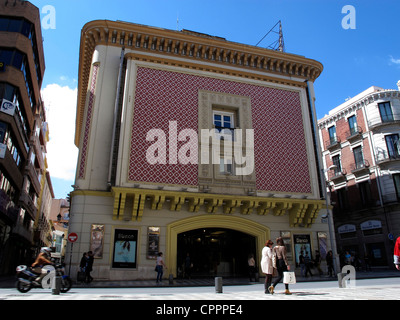
These were four viewing sessions, every hour on the hour, from 6:00 P.M. The inaugural show was presented to the general public the next day, August 29, 1897.ĭuring the first three weeks, Ramos had a selection of ten different films to show, but by the fourth week, he was forced to shuffle the 30 films in various combinations to produce new programs. A test preview was presented to a limited number of guests on August 28. The new cine was set up at Escolta, corner San Jacinto, the hall formerly occupied by the Ullman Jewelry shop. He did the acquisition with his savings, and evidently, with the financial backing of Liebman and Peritz.īy August, 1897, Liebman and Peritz presented the first movies on the Lumiere Cinematograph in Manila.
#Spanish movies in theaters now movie#
Pertierra and the centennial anniversary of the first movie shown in the Philippines should have been commemorated on January 1, 1997Īntonio Ramos, a Spanish soldier from Alhama de Aragon, who had arrived earlier in the year with the “Batallon de Cazadores” (Hunter’s Batallion), which had been sent to quell the Philippine revolution, was able to import a Lumiere Cinematograph from Paris. Other countries, such as France, England, and Germany have their claims to the introduction of publicly projected motion picture but the corresponding credit should have been given to Mr.

The show kept being postponed until the New Year.įinally, on January 1, 1897, the first four movies namely, Un Homme Au Chapeau (Man with a Hat), Une scene de danse Japonaise (Scene from a Japanese Dance), Les Boxers (The Boxers), and La Place de L’ Opera(The Place L’ Opera), were shown via 60mm Gaumont Chrono-photograph projector at the Salon de Pertierra at no. But for some reasons still unknown to this writing, Pertierra failed to make his presentation despite several published announcements to this effect. The venue was to be at Salon de Pertierra, which he established nine months earlier as the Phonograph Parlor on the ground floor of the Casino Espanol at Calle Perez, off the Escolta. It provided ready material for the nascent Filipino silent motion picture.ĭuring the last decade of the 19th century, in 1896, a Spaniard by the name of Pertierra, prepared to launch his first movie show in Manila at Christmas Time. The Tagalog zarzuela found a home at Teatro Zorilla, the only surviving 19th century theater located at the corner of Calle San Pedro ( now Evangelista ) and abbreviated the Iris which formed part of Calle Azcarraga (now Recto). The Spanish Operetta or musical comedy introduced by a political deportee from Spain, Don Narciso de Escosura, at Teatro de Binondo or Castellano in 1848, was given impetus by Don Alejandro Cubero, the father of Spanish zarzuela in the Philippines, at Teatro Filipino on Calle Echague. These were shown and performed at town fiestas where Filipino viewers go eagerly from different parts of the province so as not to miss the stage plays.

The ritual practitioners in their dance-dramas used imitative dances to propitiate the supernatural powers that were believed to control forces to regulate the seasons and elements to ensure the earth’s fertility and to grant the tribe success in hunting and warfare.Īt the turn of the 19th century, the zarzuela, a traditional Spanish one-act comic opera with satirical theme and the vaudeville, a stage show consisting of various acts, such as singing,dancing and comedy, became famous and prominent among the Filipinos. Their theatron was on the ground within the community. Long before the coming of cinema in the Philippines, theater originated in the culture of the country’s early societies. Philippine Theater Before the Advent of Cinema


 0 kommentar(er)
0 kommentar(er)
